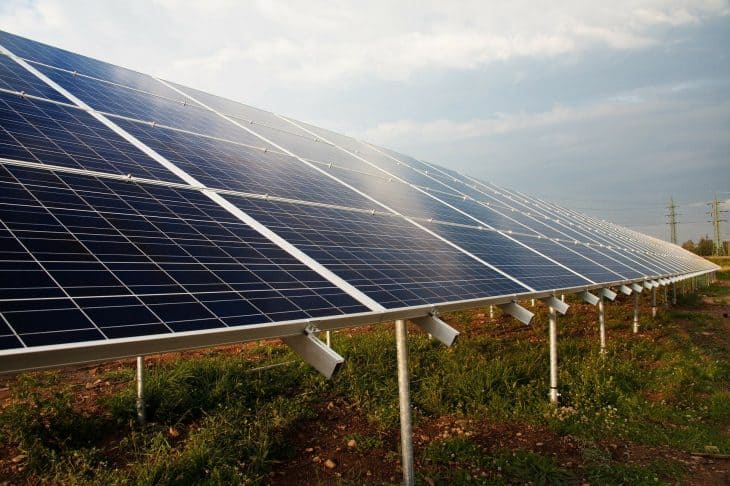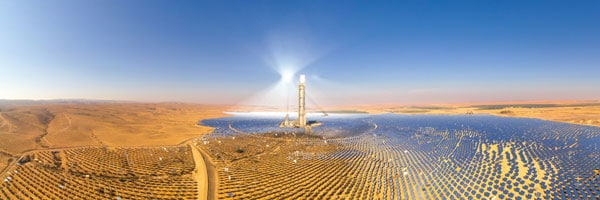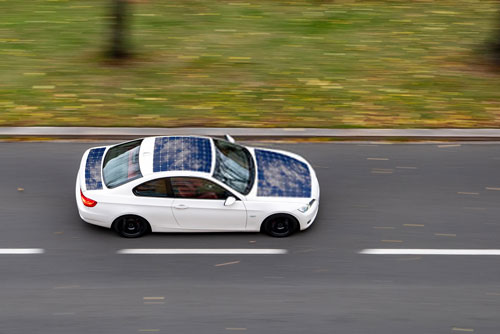
- Source: The Sun
- Definition: Energy from the Sun harnessed by advanced technology
- Advantages: Inexhaustible source, very ecological, cheaper in the long-term
- Disadvantages: Expensive technology, dependent on sunlight, bad power/size ratio
- Companies: First Solar, SunPower, Trina Solar, Canadian Solar
- Renewable: Yes
- History: Late 19th century
- Types: Passive, active
- Use: Heating, electricity, agriculture, artificial photosynthesis
- Products: Solar plants, solar vehicles, solar gadgets
- Benefits: Solar Energy Brings 4 Distinct Benefits
- Power: The Sun Provides More Energy in an Hour than We Need in a Year
- Limitations: 2 Major Factors Hinder the Spread of Solar Energy Use
- Time: Unlimited Energy Is Just 8 Minutes Away from Earth
- Types: Solar Energy Can Be Converted to Electricity via Direct or Indirect Methods
- Technology: Artificial Photosynthesis Transforms Solar Energy into Portable Fuels
- Climate: The Use of Solar Energy Can Reduce Global Warming
- History: We Have Been Using Solar Power for Centuries
- Money: Solar Power Can Greatly Reduce Living Costs
- Cost: Solar Panels Are Becoming More Efficient and Less Expensive
- Only 8% of US Energy comes from Alternative Sources
- The 7 Largest Solar Plants in the World are Located in the US
- The Average American Could Save $20,000 by Using a Home Solar System
- Solar Power Can Also Be Used at Night
- 10-25% of Solar Energy Can Be Converted into Power on Cloudy Days
- Solar Panels Have an Expected Lifespan of 25-30 Years
- The US Built the First Commercial Building to Be Heated Primarily by Solar Energy
- The First Solar Car Was Invented in 1956
- The Fastest Solar Car Comes from Japan
- Solar Panels Are Frequently Used on Spacecraft
Solar Energy Brings 4 Distinct Benefits
Solar energy facts reveal that there are four main benefits (in addition to dozens smaller ones) of humanity using solar energy. First of all, it is a vast source of energy that is renewable and inexhaustible. Second, it is available for free to anyone who has the technology to harness it. Third, it is very ecological and can greatly reduce pollution and global warming. Fourth, it will greatly decrease the cost of energy in the long-term. What’s not to like?
The Sun Provides More Energy in an Hour than We Need in a Year

Humanity uses up to about 600 exajoules (1 EJ equals 1018 joules) of energy per year. Total solar energy absorbed by the Earth’s atmosphere, oceans and land masses is nearly 4 billion EJ, and the current annual solar energy potential has been estimated at anything between 1575 and 50,000 EJ. This means that even though our energy consumption drastically rises over time, there is enough solar energy which can be harnessed on Earth to be sufficient for our needs for a very long time (probably centuries or even millennia).
2 Major Factors Hinder the Spread of Solar Energy Use
Solar energy is cheaper, cleaner, more reliable, more durable and less harmful than various other types of energy we currently use, yet a vast majority of us still drives petroleum-fueled cars, a lot of industries still use fossil fuels as their main source of energy and most of us still use electricity from nuclear and thermal power plants. Why is that?
The first factor which hinders the spread of solar energy use is technology. The technology for transforming solar energy into usable energy, although advancing fast, is not efficient enough or cheap enough to be widespread yet. The second factor is power. The modern capitalistic world is built on the use of fossil fuels, giving a lot of power and influence to those who control their extraction and commerce. Solar energy would disperse and shift this power, but power is not always an easy thing to give up…
Unlimited Energy Is Just 8 Minutes Away from Earth
The Sun is a source of limitless energy, and, although it is 90 million miles away from our planet, its energy-carrying rays need only 8 minutes and 19 seconds to reach us. It is amazing to compare how distant the source of solar energy is compared to how quickly and efficiently we can utilize it.
Solar Energy Can Be Converted to Electricity via Direct or Indirect Methods
The direct method is known as photovoltaics – a process during which solar energy gets converted into direct current with the help of special semiconducting materials. The indirect method is known as concentrated solar power (CSP) and includes the use of mirrors or lenses to concentrate sunlight into a powerful heat source, which is then transformed into electricity via connected steam turbines and power generators.
Artificial Photosynthesis Transforms Solar Energy into Portable Fuels
Artificial photosynthesis is a relatively new highly-innovative process that transforms sunlight, water and carbon dioxide into various carbohydrates and oxygen. These compounds can be used in various efficient alternatives to fossil fuels since they can be easily stored and transported across the globe.
The Use of Solar Energy Can Reduce Global Warming
Solar energy could eventually replace all other kinds of polluting energy we currently utilize, therefore decreasing the amount of greenhouse gases emitted into the atmosphere. This would greatly slow down the process of global warming, which poses a serious threat to our planet’s existence.
We Have Been Using Solar Power for Centuries
Solar energy facts reveal that the first documented use of solar energy, although extremely simple, can be traced back to 7th century BC, when people used magnifying glasses to light fires. The world’s first solar collector was built in 1767 by a Swiss scientist Horace de Saussure, and it was used for cooking food and heating water. In mid-19th century, the photovoltaic effect was discovered, but was efficiently used only more than a century later, in 1954, when Bell Labs created the first solar cell, which converted solar energy into electrical power.
Although the use of solar energy became wide-spread only in the recent decade or two, most of us have been using it for quite a few decades. Don’t think so? Just remember using calculators with a small solar cell, for example – they have been around ever since the 1970s.
Solar Power Can Greatly Reduce Living Costs

Not only because it will greatly reduce your electricity and heating bills, but also because there are various tax incentives and subsidies for those who decide to invest in solar power technology and use it at home. These financial incentives make the initial investment of buying the technology much more budget-friendly, and cause the technology to pay off years earlier than it normally would.
Solar Panels Are Becoming More Efficient and Less Expensive
Utilizing solar energy is not just a matter of the future – it is here, now, available to be exploited by us all. Solar panels for home use (usually installed on roofs) are gradually becoming more efficient – most of them nowadays reach an efficiency of 12-18%, which means that they convert 12-18% of sunlight into electrical power. At the same time, the technology is also becoming less expensive, especially due to China becoming the strongest global force in solar power. The cost of solar panels has decreased by a whopping 80% since 2008!
Only 8% of US Energy comes from Alternative Sources
One of the most interesting solar energy facts clearly shows that there is much room for improvement. It is also interesting to note that solar energy represents only 1% of total energy used in the US. Hydropower still represents about 35%, wood 24% and biofuels 20%.
The 7 Largest Solar Plants in the World are Located in the US

Solar energy facts also reveal that six of them, including the two largest ones, are found in the state of California. The title of the largest solar plant in the world is shared between the Topaz Solar Farm in San Luis Obispo County and the Desert Sunlight Solar Farm in Desert Center in the Mojave Desert – they each have a capacity of 550 megawatts (MW). First Solar, Inc. planned to build the world’s largest solar plant – to be named Ordos (2000 MW) – in China, but canceled the project in 2014.
The Average American Could Save $20,000 by Using a Home Solar System
We are talking about savings over a 20-year period, but that still equates to $1,000 each year. And, in some US states, where the prices of electricity are higher, this number becomes even bigger: it would be possible to save around $65,000 in Hawaii and around $35,000 in California over a period of 10 years. These figures will only increase as the years go by, since solar technology continually becomes cheaper.
Solar Power Can Also Be Used at Night
Sure, the power cannot be harnessed during the night, since sunrays are essential for that, but energy collected during the day can be saved in practically all solar-fueled devices and used at any time – including during the night.
10-25% of Solar Energy Can Be Converted into Power on Cloudy Days
Solar energy facts reveal a myth that solar energy cannot be harnessed and converted into power during cloudy days. The myth is of course false, since some sunlight always penetrates through the clouds. How much depends on the thickness and the type of clouds.
Solar Panels Have an Expected Lifespan of 25-30 Years
After that period, they need to be replaced, which requires an additional investment, but this investment is nothing compared to how much solar energy users can save over these 25-30 years…
The US Built the First Commercial Building to Be Heated Primarily by Solar Energy
Solar energy facts show that the building known as the Solar Building, or Bridges-Paxton Building, is located in Albuquerque, New Mexico, and was built in 1956 for $58,500.
The First Solar Car Was Invented in 1956

It was created by William G. Cobb of General Motors and was not appropriate for actual driving. But, nowadays, we have solar cars that boast a range of 250 miles and can reach speeds of over 50 miles per hour.
The Fastest Solar Car Comes from Japan
And no, it is not a Mitsubishi, a Toyota, a Mazda or a Nissan, but an Ashiya University project named Sky Ace TIGA. It is the fastest land vehicle powered only by solar panels, with a top speed record of 56.75 mph, set in August 2014. Cars that combine solar power and traditional power can go much faster, of course, reaching the same speeds as regular cars.
Solar Panels Are Frequently Used on Spacecraft
Thanks to Dr. Hans Ziegler, it all began in 1958 with the Vanguard 1 satellite. Dr. Ziegler’s vision has been re-used on numerous other spacecraft over the following decades, including SMART-1, Mars Observer and the Hubble Space Telescope. Solar energy is used to run sensors, telemetry, temperature regulation and propulsion in these space-exploring objects.
Solar Energy Facts — Facts about Solar Power Summary
 Solar energy is the energy from the Sun and can be harnessed and transformed to solar power, and used as an alternative to existing energy sources. Solar energy is clean, cheap, unlimited and easily accessible, and is thus considered to be the energy of the future. It can be harnessed and used in many ways, but most of the world still chooses to use nonrenewable sources of energy such as fossil fuels. One of the reasons for that is because solar energy is expensive and only moderately efficient, and the other is the power of the lobbies that control traditional sources of energy.
Solar energy is the energy from the Sun and can be harnessed and transformed to solar power, and used as an alternative to existing energy sources. Solar energy is clean, cheap, unlimited and easily accessible, and is thus considered to be the energy of the future. It can be harnessed and used in many ways, but most of the world still chooses to use nonrenewable sources of energy such as fossil fuels. One of the reasons for that is because solar energy is expensive and only moderately efficient, and the other is the power of the lobbies that control traditional sources of energy.
Was this page helpful?
Our commitment to delivering trustworthy and engaging content is at the heart of what we do. Each fact on our site is contributed by real users like you, bringing a wealth of diverse insights and information. To ensure the highest standards of accuracy and reliability, our dedicated editors meticulously review each submission. This process guarantees that the facts we share are not only fascinating but also credible. Trust in our commitment to quality and authenticity as you explore and learn with us.


